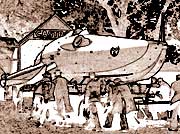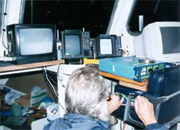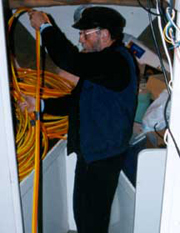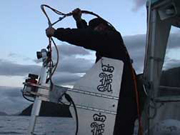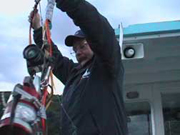On September 29 1952 John Cobb, the famous Brooklands
racing hero, holder of many speed records, died after
his boat Crusader disintegrated after hitting a boat-wake
during a world water speed record attempt on Loch Ness.
He became the fastest man on water (206.89mph) though
did not achieve the record since the accident occurred
before he could complete a second run over the measured
mile.
At the end of the measured mile Crusader nose-dived
into the deep dark waters of Loch Ness. John Cobb's
body was swiftly pulled from the water by his support
team and the wreckage from crusader sank to depths of
over 200m.
Smaller pieces of the boat, blown off by the
crash, were found floating and taken away to be burned
on the shore.
Later, a memorial cairn was built at the loch-side
by the local people to the memory of a "gallant
gentleman".
The Loch Ness Project decided to search for
Cobb's boat in 2001, since this year is to be the 50th
year since the tragedy. Using photography, archive film
and digital image analysis, Adrian Shine began to plot
the probable location of the wreckage of Crusader.
Over a period of 18 months, working from his
laboratory at the Loch Ness 2000 Exhibition Centre,
and the Loch Ness Project research vessel "Deepscan",
Adrian identified strong sonar contacts during night
searches of the area.
Skipper, John Minshull and Adrian Shine spent
many long nights sweeping the plotted line with sonar
and mapping the site.
This year as they closed in on the wreck they
were joined by Gary Richardson, manager of Loch Ness
2000 and by other Loch Ness Project members and volunteers
including David Martin, Elaine Minshull and Maralyn
Shine.
By June the Loch Ness Project felt confident that they
had found a debris field. At this point the American
Academy of Applied Science, on expedition at the loch, announced an interest in finding the Cobb wreck during
the last 2 days of their visit and were to be assisted
by Gordon Menzies, a resident, owner of Temple Pier
and as a child, witness of the record attempt.
Adrian Shine presented the Project's data to
the Academy team. Bob Rines, calling from the U.S.A, immediately offered the Loch Ness Project assistance
from his Cabaco owned ROV with pilot Joe Caba and pilot Mike
Nicholson of Deep Sea Systems aboard the vessel Boy
David (Skipper Ken and David Skea).
On Thursday the 4th July exmination
of the sonar contacts began and on Friday 5th July Adrian navigated the ROV over the search line and
at 3pm what appeared to be the remains of Crusader,
stark, angular and twisted loomed out of the dark sitting
quietly in 200m of water. But was it bits of Crusader?
Loch Ness Project and Kongsberg find John Cobb's Crusader wreck with its jet engine 28th April 2019.
It was 19 years before the Crusader was discoverd by Adrian Shine and Craig Wallace of Kongsberg with his Munin AUV. On board Deepscan were John from Kongsberg, Skipper John Minshull and videographer Maralyn Shine. Alastair Matheson accompanied Gordon Menzies who had offered his boat to act as a steadying tow to Deepscan in the rising weather conditions.
More info to follow.....
Digital Imagery - Maralyn Shine, Loch Ness Project
Photographic help and inital calculations from Dick
Raynor.
ROV Team -Academy
of Applied Science
|

Sketch of Crusader's Jet Engine 
Scaling and mapping the site
|


